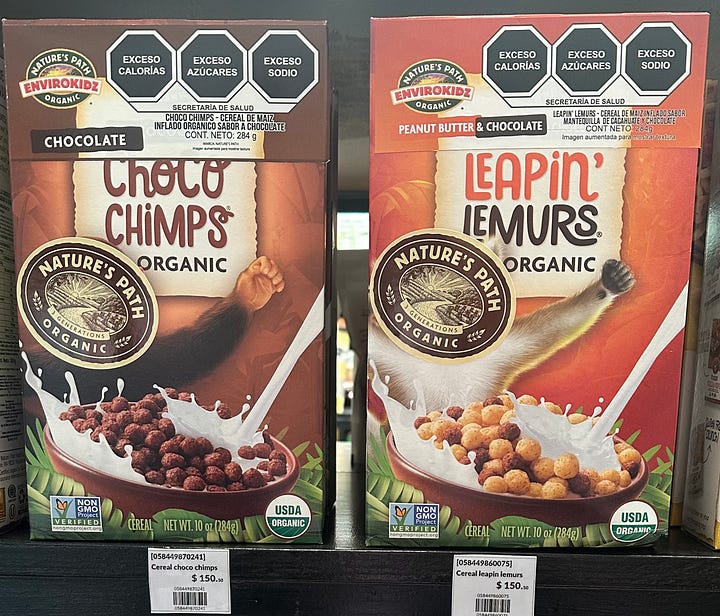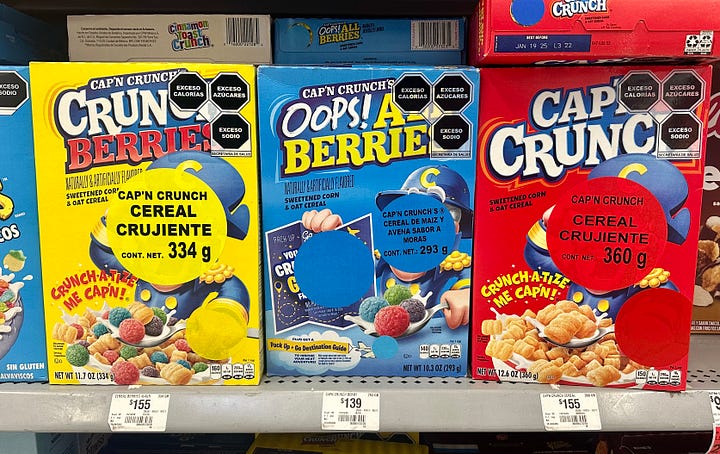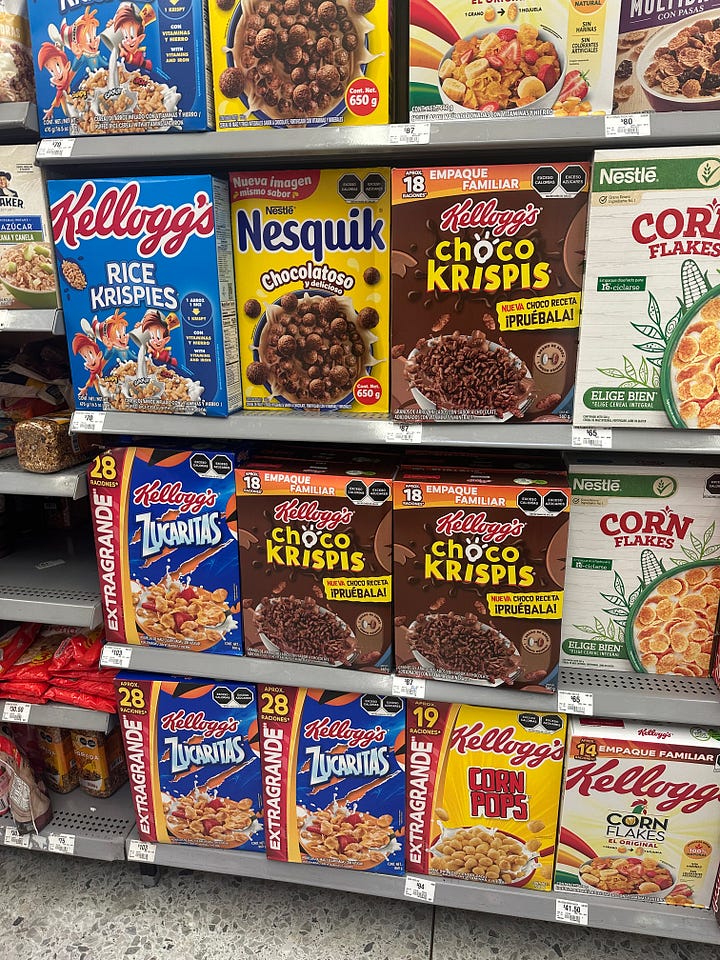eyes eat first, especially at the grocery store
looking at front-of-package nutrition labels and redacted cereal mascots on a recent trip to Mexico City...can the U.S do the same?
My hiatus from writing the last week is the result of a fantastic trip to Mexico City (more on that in future posts). Last week’s trip renewed my fascination in food labeling used in other countries in two key areas: (1) front-of-package nutrition labeling (FOPNL) showing the healthfulness or lack thereof of an item and (2) limitations on brands using mascots to target kids to sell unhealthy packaged items, particularly cereal items. Package labeling has been used as a policy measure to help combat rising rates of obesity and other diet-related disease around the world. Currently, the U.S. does not have labeling of this sort but the FDA did put forth a proposal to do so mere days ago.
While I think this would be a huge step forward in the fight against rising diet-related diseases, read below and drop a comment to let me know what you think!
front-of-package nutrition labeling (FOPNL)
Research conducted by UNICEF based on 32 countries around the world that have enacted FOPNL found that interpretive labels, such as ones using color and symbols in meaningful ways to convey judgements about food, performed better than non-interpretive labels (i.e., what we currently have in the United States). These types of labels require no literacy and no numeracy to comprehend which is what makes them so successful and arguably, more equitable.
Below are two examples in two different countries. In Mexico, items with excess nutritional harms (i.e. calories, sugar, sodium, etc.) are labeled with a black octagon prominently on the front (i.e., stop sign warnings). In Europe, a Nutri-Score scale labeled from A for healthiest to E to least healthy is on the bottom left of packaged food (i.e., spectrum rating). The former utilizes a nutrient-specific warning label with the latter, adopting a summary indication but both convey pertinent information without having to even pick up the package.


banning mascots on food products
Mexico is one of many countries that has enacted bans on mascots gracing the colorful and fun packages of unhealthy foods that target children. Cereal is the most notorious example of this. Take a wander down any cereal aisle in Mexico and you will either see giant stickers covering a mascot’s face or a re-styled package devoid of any cartoonish characters if any black octagons also grace the package. Note in the photos below, Rice Krispies is the only cereal shown here that does not have a black octagon warning and thus, does not need to cover the mascot trio.


does this work?
While it can take time to see if these policies have a long term, lasting impact, signs point to the fact that yes, these labels have a positive impact. While Mexico approved its FOPNL law in early 2020, Chile was an early adopter of the black octagons, implementing their usage in 2016. Since the implementation of the new labeling policies, individuals in Chile have reduced their sugar intake by over 10 percent based on research from the University of North Carolina and the University of Chile. Companies have also started to reformulate to avoid negative FOPNL warnings.
why don’t we have FOPNL in the U.S?
In a March 2023 U.S.-based survey, 75% of consumers responded favorably to mandatory front-of-package nutrition labeling policy, including majority margins across Democrats, Republicans and Independents. So why do we not have this type of labeling in the United States? Presumably, food manufacturers are the largest opponent to new labeling requirements due to the initial costs of packaging changes, potential dips in business and eventually, product reformulations. Manufacturers often claim that individuals have free choice already or that FOPNLs are not effective, but as studies have shown, comprehension of nutritional information varies across demographics.
It is my firm belief that there should be no prerequisites in experience, education or circumstance required to understand a nutrition label.
In a nutshell, further steps need to be taken to arm the average consumer with tools to alleviate the rampant information asymmetry that exists in our food supply. Policy methods enabling consumers to make more informed choices such as enacting front-of-package nutrition labeling can be an effective approach to shift behaviors around unhealthy and ultra-processed foods for both consumers and manufacturers. It is the hope that better labeling will raise consumer awareness which can in turn, add pressure to both manufacturers and the government to make necessary changes to limit unhealthy, ultra-processed products in our food supply.
Do you think front of package labels or blocked characters on food targeting kids will be effective in the United States? Do you live somewhere this has been enacted and have you noticed an impact? Drop a comment below to let me know what you think!
Sources
Nestle, Marion. “Consumers Don’t Want to Be Told What to Eat, but Need Guidance.” The Atlantic, 6 Nov. 2011, www.theatlantic.com/health/archive/2011/11/consumers-dont-want-to-be-told-what-to-eat-but-need-guidance/247962.
Nutrition and Child Development Section, Programme Group. “Front-of-Pack Nutrition Labelling: A ‘How-to’ Guide for Countries.” UNICEF Technical Guidance, United Nations Children’s Fund (UNICEF), Nov. 2021, www.unicef.org/media/118716/file.
International Food Information Council. Consumer Survey: Public Perceptions of Processed Foods in a Healthy Diet. 2024, foodinsight.org/wp-content/uploads/2024/01/IFIC-Processed-In-A-Healthy-Diet.pdf.
CSPI and Big Village. “Widespread Support for Mandatory Front-of-Package Labeling in the United States.” CSPI Commissioned National Survey, report, 2023, www.cspinet.org/sites/default/files/2023-04/FOPNL%20Public%20Opinion%20Fact%20Sheet_final.pdf.
Global Health Advocacy Incubator. Front of Package Labeling – Industry Arguments Counter Messages and Evidence. 11 Aug. 2021, dfweawn6ylvgz.cloudfront.net/uploads/2021/08/Evidence_to_Support_FOPL.pdf.
Jones, Alexandra, et al. “Front-of-pack Nutrition Labelling to Promote Healthier Diets: Current Practice and Opportunities to Strengthen Regulation Worldwide.” BMJ Global Health, vol. 4, no. 6, Dec. 2019, p. e001882. https://doi.org/10.1136/bmjgh-2019-001882.





The FOPNL would be a nice time saver and quick reference for everyone, however especially useful for parents that are shopping with young children in tow.